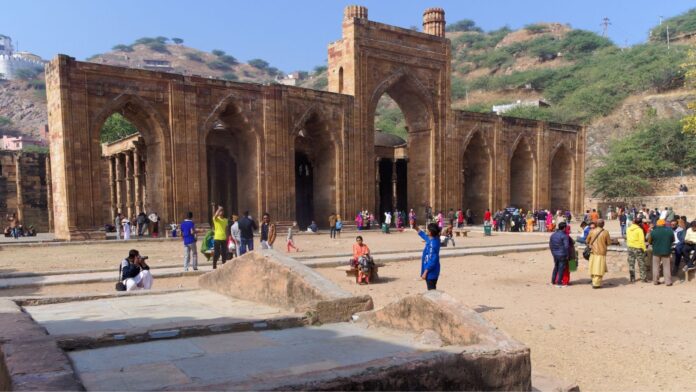In the wake of a petition for a survey of Ajmer Sharif Dargah, a similar demand has emerged for the historic Adhai Din Ka Jhonpra, one of the oldest mosques in India. Ajmer’s deputy mayor Neeraj Jain has revived calls for a survey, claiming evidence of an ancient Sanskrit college and a temple at the site that was allegedly demolished during invasions.
Jain stated, “There has been evidence of a Sanskrit college and temple in the Jhonpra. It was demolished by the invaders the same way they demolished (historical education sites) Nalanda and Takshila. There was an attack on our culture, our civilisation, our education and this (Jhonpra) too was among them.” His remarks came shortly after a petition calling for a survey of Ajmer Sharif Dargah was admitted by a local court. The petition has brought renewed attention to the historical and cultural significance of Adhai Din Ka Jhonpra.
Adhai Din Ka Jhonpra, located just a few minutes’ walk from Ajmer Sharif Dargah, is a monument protected by the Archaeological Survey of India (ASI). According to Jain, the ASI possesses over 250 statues from the site, and there are inscriptions, swastikas, bells, and Sanskrit shlokas that suggest the site’s historical Hindu origins. “We have demanded this in the past too, that existing religious activities should be stopped and the ASI should ensure the return of the college’s old glory,” Jain said.
The ASI, which is responsible for the upkeep of the site, states that the name “Adhai Din Ka Jhonpra” may have originated from the fair, or Urs, held at the site for two and a half days. Historian Har Bilas Sarda, in his 1911 book Ajmer: Historical and Descriptive, suggested that the name was given to the monument in the late 18th century when fakirs gathered to celebrate the two-and-a-half-day Urs in honor of Panjaba Shah, a religious leader who had migrated to Ajmer from Punjab.
Sarda also claimed that the site was originally home to a Jain temple built in 660 AD by Seth Viramdeva Kala in celebration of the Jain festival Panch Kalyan Mahotsava. This temple, according to Sarda, was built to provide a place for the Jain priestly class to stay during their visits to Ajmer. However, the temple was allegedly destroyed by Muhammad Ghori and his forces in 1192 AD, and the structure was converted into a mosque.
The ASI adds that the current structure was built by Qutubuddin Aibak around 1200 AD, using the remnants of earlier structures, including carved pillars. The mosque’s prayer chamber is notable for its nine octagonal compartments and the two small minarets that crown the central arch. The three arches at the center, intricately carved with Kufic and Tughra inscriptions, are considered architectural masterpieces and contribute to the site’s historic value.
This renewed demand for a survey comes on the heels of a similar call in May by Rajasthan Assembly Speaker and Ajmer North MLA Vasudev Devnani. Devnani, along with Jain monks and members of the Vishwa Hindu Parishad, had visited the site and claimed that a Sanskrit school and a temple once stood where Adhai Din Ka Jhonpra stands today. They urged the ASI to conduct a detailed survey to verify these claims.
The demand for an investigation into Adhai Din Ka Jhonpra is seen by some as part of a broader effort to re-examine the historical and cultural narrative of India’s religious monuments. While many see it as an attempt to uncover lost heritage, others worry about the implications for religious harmony in the region, as such efforts often stir controversy and fuel communal tensions.
As the matter gains momentum, the ASI’s stance on conducting a survey at Adhai Din Ka Jhonpra remains uncertain. The monument, significant for its architecture and history, continues to be a focal point in debates about India’s cultural heritage, with its future likely influenced by both historical evidence and current political dynamics.

